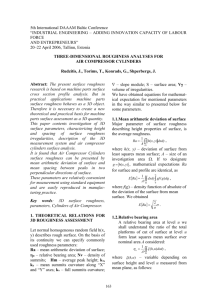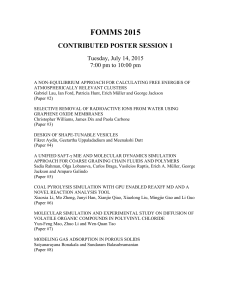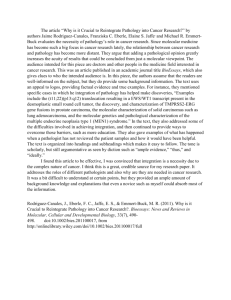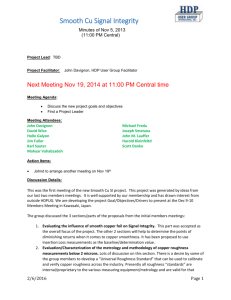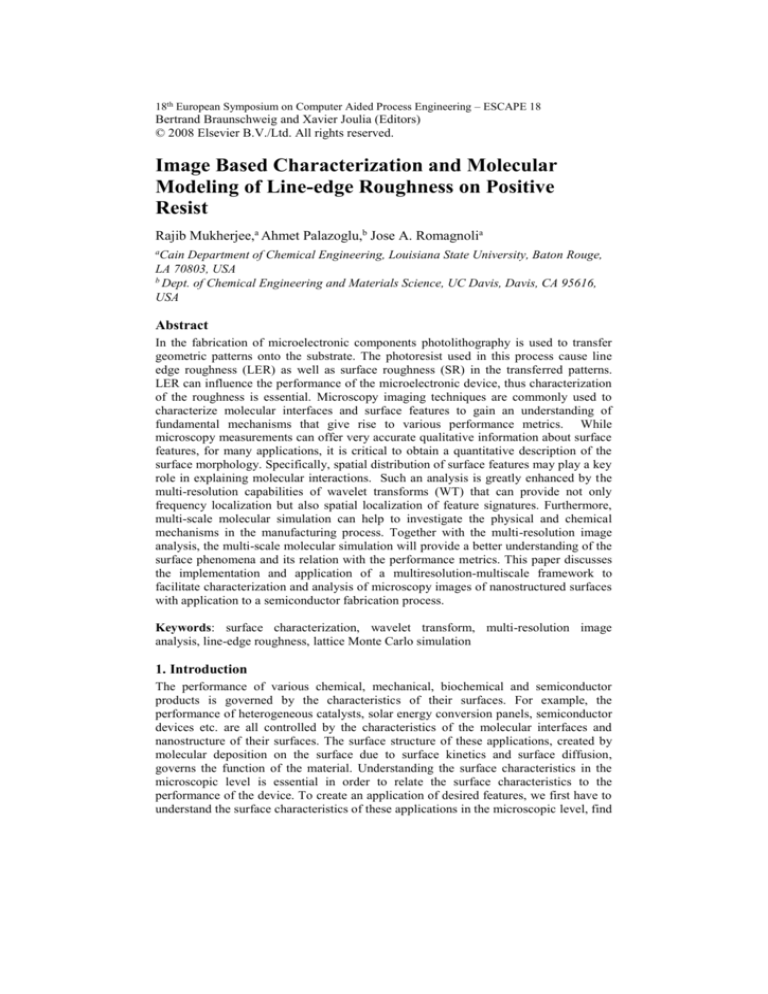
18th European Symposium on Computer Aided Process Engineering – ESCAPE 18
Bertrand Braunschweig and Xavier Joulia (Editors)
© 2008 Elsevier B.V./Ltd. All rights reserved.
Image Based Characterization and Molecular
Modeling of Line-edge Roughness on Positive
Resist
Rajib Mukherjee,a Ahmet Palazoglu,b Jose A. Romagnolia
a
Cain Department of Chemical Engineering, Louisiana State University, Baton Rouge,
LA 70803, USA
b
Dept. of Chemical Engineering and Materials Science, UC Davis, Davis, CA 95616,
USA
Abstract
In the fabrication of microelectronic components photolithography is used to transfer
geometric patterns onto the substrate. The photoresist used in this process cause line
edge roughness (LER) as well as surface roughness (SR) in the transferred patterns.
LER can influence the performance of the microelectronic device, thus characterization
of the roughness is essential. Microscopy imaging techniques are commonly used to
characterize molecular interfaces and surface features to gain an understanding of
fundamental mechanisms that give rise to various performance metrics. While
microscopy measurements can offer very accurate qualitative information about surface
features, for many applications, it is critical to obtain a quantitative description of the
surface morphology. Specifically, spatial distribution of surface features may play a key
role in explaining molecular interactions. Such an analysis is greatly enhanced by the
multi-resolution capabilities of wavelet transforms (WT) that can provide not only
frequency localization but also spatial localization of feature signatures. Furthermore,
multi-scale molecular simulation can help to investigate the physical and chemical
mechanisms in the manufacturing process. Together with the multi-resolution image
analysis, the multi-scale molecular simulation will provide a better understanding of the
surface phenomena and its relation with the performance metrics. This paper discusses
the implementation and application of a multiresolution-multiscale framework to
facilitate characterization and analysis of microscopy images of nanostructured surfaces
with application to a semiconductor fabrication process.
Keywords: surface characterization, wavelet transform, multi-resolution image
analysis, line-edge roughness, lattice Monte Carlo simulation
1. Introduction
The performance of various chemical, mechanical, biochemical and semiconductor
products is governed by the characteristics of their surfaces. For example, the
performance of heterogeneous catalysts, solar energy conversion panels, semiconductor
devices etc. are all controlled by the characteristics of the molecular interfaces and
nanostructure of their surfaces. The surface structure of these applications, created by
molecular deposition on the surface due to surface kinetics and surface diffusion,
governs the function of the material. Understanding the surface characteristics in the
microscopic level is essential in order to relate the surface characteristics to the
performance of the device. To create an application of desired features, we first have to
understand the surface characteristics of these applications in the microscopic level, find
2
R..Mukherjee et al.
the relation of product performance with surface characteristics, thereby improve the
product performance through optimizing the manufacturing process towards novel
tailored nanostructres. Thus, the key to control fabrication of applications whose
performance matrix is governed by its surface feature is to characterize the surface and
use those characteristic features as control parameters. In this way we can optimize
product performance as well as have a quality control. Surface characterization in
micro/nano structure is thus an essential part of engineering device fabrication.
Characterization of a micro/nano structure is performed by analyzing its image. The
image of micro/nano structures can be taken using a Scanning Electron Microscope
(SEM), or a Scanning Probe Microscope like an Atomic Force Microscope (AFM).
Various image processing tools can be used to analyze those surface images and find the
characteristics of the surface. Wavelet analysis method has been adopted in the present
study. In wavelet analysis, we implement multi-resolution methodology for the analysis
of microscopic images. The underlying physico-chemical mechanism of the atoms and
molecules is the key to decide the appearance of a surface and therefore the surface
image. A multi-scale molecular simulation can help to investigate the physical and
chemical mechanism in the process. In multi-scale molecular simulation, we predict
behavior in one scale by carrying out modeling in another scale. The surface
characteristic features are in the nano scale as they are the features of surface molecular
structure. But they are controlled by manufacturing parameters which are in the macro
scale. So a multi-scale molecular simulation is required where we have to design and
control nanoscopic behavior by macroscopic manufacturing variable manipulation. The
characteristic features obtained from the multi-resolution image analysis are reproduced
using multi-scale molecular simulation. This enables us to understand and de-correlate
different manufacturing parameters that yield a particular characteristic of the product.
Together with multi-resolution image analysis the multi-scale molecular simulation will
provide a better understanding of the surface phenomena and its relation with the
performance metrics.
2. Multi-resolution /Multi-scale Framework for Surface Characterization
A multi-resolution multi-scale methodology to facilitate characterization and analysis of
dynamic microscopy images of nanostructured surfaces is proposed. By combining
multi-resolution image analysis, multi-scale molecular simulation and product
performance testing, we can get better understanding of manufacturing process, i.e. how
manufacturing conditions affects surface characteristics and hence the product
performance. Figure 1 illustrates, schematically, the basic framework.
Figure 1: Project Framework
Figure 2: 2-D three level DWT
Image Based Characterization and Molecular Modeling of Line-edge Roughness on
Positive Resist
2.1. Multi-Resolution Image Analysis by Wavelet Transform
Any surface image can be considered as a combination of the actual surface features and
the imaging artifacts (noise). Even for the actual surface itself, three main features are
very often isolated. These are namely the roughness, the waviness and the form which
can be considered as a multi-resolution signal combination [1]. Multi-resolution
representation by the wavelet transform can successfully break the image signal into
different resolutions and retain all spatial information at the same time. Discrete wavelet
transform (DWT) is performed on the image by the Filter Bank method [2]. It is shown
in Figure 2. The most convenient way to evaluate different surface characteristic
features is by computing the wavelet coefficients. A surface can be characterized by
statistical measures like skewness, flatness (kurtosis) and fractal dimension. The
moments of the wavelet coefficients provide an alternative and more efficient way to
calculate these statistical properties.
2.2. Multi-scale molecular simulation
Image analysis is limited by the pixel resolution. Hence the surface properties are
expressed in the resolution of the pixel. To understand and quantify the effect of
manufacturing parameters on surface characteristics, simulation of the system is the
most convenient way. In multi-scale molecular simulation we use the fundamental
physical properties of molecules in one scale to define the structure and function of the
surface formed by the molecules at another scale. Depending on the length-scale of
interest, different molecular simulation methods are used.
2.3. Combining Multi-Resolution Image Analysis with Molecular Simulation
Molecular simulation is done to understand the manufacturing parameters, decouple the
effect of different parameters and explain their effects. Standard analysis techniques like
density profiles and density distributions as well as direct visualizations of the
underlying models as all positions of the particles are known. Wavelet decomposition
can be applied to the visualization of the simulation and analyze the results in the same
way as for the experimental image data. The high resolution direct space simulation data
allows assigning direct meanings to the different features obtained from the wavelet
analysis and, in turn, would allow refinement of the simulation models.
3. Application: Line-edge roughness (LER) in semiconductor fabrication
In microelectronic fabrication, lithography is used for pattern transfer in the substrate.
Edges are created on the substrate by pattern transfer through the process of lithography.
Lithography includes formation of a pattern with a photoresist polymer upon the
substrate. The steps in the process include; the spun of the photoresist in the substrate
by a high speed spinner, pre baking, exposure of the photoresist, developing and post
exposure baking. After the development, edges are formed on the resist. The roughness
of the photoresist polymer on its edges causes the LER and the unevenness of the
photoresist polymer surface causes the surface roughness on the substrate [3]. A
complete characterization of LER is a starting point for all these efforts, which can give
important information about the device. In this paper, LER formed on a photoresist has
been characterized using the SEM image of the photoresists. The different LER
characterization parameters will relate information about fabrication process with the
performance of the device. The characterization of this roughness of the photoresist is
carried out by evaluating parameters like sigma value, roughness exponent, correlation
length etc.
The image analyzed is a SEM micrograph of a 1740 line/mm plane diffraction grating,
holographically produced on a 50 mm diameter fused silica substrate. The grating lines
3
4
R..Mukherjee et al.
are in photoresist, nominally 550 nm tall and 150 nm wide, with nominally vertical
sidewalls. Figure 3a shows the original image. The characterization is done to identify
the uniformity of the edge and its deviation from the ideal straight line.
(a)
(b)
(c)
Figure 3: (a) Original image (b) enhanced SEM image and (c) horizontally positioned SEM image
showing the region selected for image processing
Image enhancement is performed by intensity normalization, as shown in Fig. 3b. The
image is first rotated to position the edge horizontally and a 512 512 pixel image is
selected for further study as shown in Fig. 3c. The experiment was carried out and the
image was recorded at the Lawrence Livermore National Laboratory, Livermore, CA.
3.1. Line-edge characterization
The LER parameters can be estimated at different threshold values. Given a threshold
value, the line-edge boundaries are found by a signal threshold algorithm (Fig. 4) [4]
and then the LER calculation is performed. To find the line edge boundaries at a given
threshold the edge searching region is first found from the optimum wavelet
decomposition level [5].
Figure 4: Edge boundaries by Daubechies3 wavelet functions at threshold value 0.3
There are several ways to characterize the line edge roughness. The “sigma” value is the
most straightforward one and most closely related to the line boundary. It is defined as:
Np 2
i 1 i
Np
1
where Np is the number of points along the line edge, and is the signed distance of
each edge point from the linear fit to the line edge [4].
LER is also characterized using roughness exponent and correlation length. There are
various ways to estimate the exponent and to find the correlation length. Traditionally,
correlation function and Fourier transform are used for this purpose. The Hurst
exponent and thus fractal dimension of LER is estimated from the slope of the
logarithmic plot of the distance correlation function G(r) where r md . Here m is an
integer and d is the length between two neighboring points. It is defined as [6]:
Image Based Characterization and Molecular Modeling of Line-edge Roughness on
Positive Resist
1 N m
i m i 2
G(md )
N m i 1
5
1/ 2
2
In this paper wavelet transform is proposed to calculate the correlation length and Hurst
exponent. In traditional methods a visual interpretation is required to find the correlation
length and the slope from the plot of correlation function or spatial frequency
distribution. In the proposed approach an image dependent estimation of the scale index
through which the self affine nature of the line-edge roughness persist can be made and
no visual interpretation is required.
(a)
(b)
(c)
Figure 5: Correlation length and roughness exponent from (a) correlation function, (b) Fourier
transform, (c) Wavelet variance
From Fig. 5a and 5b, the exponent is found from the slope of the curve up to the point
that it varies linearly. For the correlation function and the Fourier transform, a visual
interpretation is required for correlation length and exponent estimation. A plot of
wavelet variance which is obtained from wavelet transform at different scale index is
shown in Fig. 5c. It shows a change in the nature of the variance after a certain scale.
This value of scale index gives the correlation length and slope of the linear fit gives the
Hurst exponent.
3.2. Molecular Simulation
A molecular simulation is carried out for a positive photoresist to understand the
underlying structure and find the variables on which the LER is depended. A 3D
mesoscale lattice Monte Carlo simulation is performed. In lattice MC molecules occupy
discrete positions inside the lattice and a molecule can occupy a single lattice site as in
the case of a solvent or it can occupy several lattice sites as in case of a polymer chain.
Each molecule (solvent molecule or monomer unit of polymer) can attract or repel a
neighboring molecule depending on the potential energy between them called
interaction potential. At equilibrium, the structure of the polymers within the solution
will depend upon this interaction potential which in turn depends upon the difference in
solubility of the polymer and solvent molecules. A cubic lattice is used. The system
contains Novolac resin polymer, Naphthoquinone diazide as photoresist, Ethyl 3ethoxypropionate and ethyl lactate as solvents. Due to the difference of solubility
parameters of the polymer and the solvents, the polymer chains try to come closer
forming clusters. A polymer chain is chosen randomly and three different moves are
employed. They are reptation, twist and configurational bias [7]. Simulation results
from configurational bias seem to over predict the roughness values obtained from the
image analysis. Movement from reptation and twist are only used for this analysis. At a
typical manufacturing condition, a sigma value of 8.34 nm is obtained. From the image
at threshold value of 0.3, we get sigma value of 13.3 nm. A number of simulations have
also been performed to investigate the effect of manufacturing parameters such as
6
R..Mukherjee et al.
polymer chain length, amount of photoresist and the amount of solvent on roughness
(only the effect of the amount of solvent is shown here). The chain length appears to
have no effect. For more than 10 volume percent of photoresist, the roughness is
independent of its amount. This may be because all the polymers are attached to the
photoresist and they are not removed during development.
(a)
(b)
Figure 6: Variation of roughness with (a) amount of photoresists, (b) amount of solvent Ethyl 3ethoxypropionate
Figure 6a and 6b show the effect of amount of solvents on roughness. An increase of
volume percent of solvent will always increase the roughness as due to difference in
solubility parameters of polymers and solvents, increase in solvent creates more clusters
of the polymers.
4. Conclusions
Estimation of surface characterizing features through wavelet variance over
conventional methods has the advantage that it can be solely image dependent and can
be performed online. A properly designed molecular simulation can replicate the
experimental condition. We know the simulation parameters that give a particular
characteristic of the simulated polymer surface. By comparing the simulated surface
characteristics with that obtained from the image analysis of experimental surface, we
can see the effect of different manufacturing parameters in surface characteristics. Thus,
a computational framework is created to obtain the optimum manufacturing condition
for a particular surface characteristic.
References
1. B. Josso, D.R. Burton, M.J. Lalor, 2002, “Frequency Normalized Wavelet Transform for
Surface Roughness Analysis and Characterization”, Wear, 252, pp491-500
2. G. Strang, T. Nguyen, 1996, “Wavelets and Filter Banks”, Wellesley-Cambridge Press:
Wellesley
3. G.P. Petsis, E. Gogolides, 2001, “Simulation of surface and line-edge roughness formation
in resists”, Microelectronic Engineering, 57-58, pp 563-569
4. G.P. Patsis, V. Constantoudis, A. Tserepi, E. Godolides, G. Grozev, 2003, “Quantification
of line-edge roughness of photoresists. I. A comparison between off-line and on-line
analysis of top-down scanning electron microscopy images”, J. Vac. Sci. Technol. B,
21(3), pp1008-1018
5. W. Sun, R. Mukherjee, P. Stroeve, A. Palazoglu, J.A. Romagnoli, 2007, “ A Multi
Resolution Approach for Line Edge Roughness Detection”, Microelectronic Engineering,
submitted
6. V. Constantoudis, G.P. Patsis, A. Tserepi, E. Godolides, 2003, “Quantification of line-edge
roughness of photoresists II. Scaling and fractal analysis and the best roughness
description”, J. Vac. Sci. Technol. B, 21(3), pp 1019-1026
7. D. Frenkel, B. Smit, 2002, “Understanding molecular simulation : from algorithms to
applications”, 2nd edition, Academic Press



